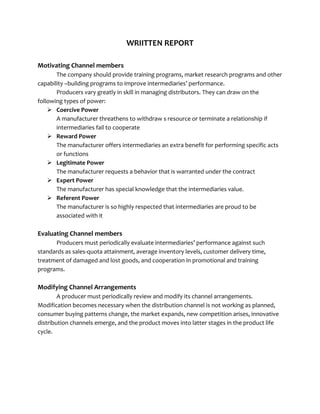
Juriz
- 1. WRIITTEN REPORT Motivating Channel members The company should provide training programs, market research programs and other capability –building programs to improve intermediaries’ performance. Producers vary greatly in skill in managing distributors. They can draw on the following types of power: Coercive Power A manufacturer threathens to withdraw s resource or terminate a relationship if intermediaries fail to cooperate Reward Power The manufacturer offers intermediaries an extra benefit for performing specific acts or functions Legitimate Power The manufacturer requests a behavior that is warranted under the contract Expert Power The manufacturer has special knowledge that the intermediaries value. Referent Power The manufacturer is so highly respected that intermediaries are proud to be associated with it Evaluating Channel members Producers must periodically evaluate intermediaries’ performance against such standards as sales-quota attainment, average inventory levels, customer delivery time, treatment of damaged and lost goods, and cooperation in promotional and training programs. Modifying Channel Arrangements A producer must periodically review and modify its channel arrangements. Modification becomes necessary when the distribution channel is not working as planned, consumer buying patterns change, the market expands, new competition arises, innovative distribution channels emerge, and the product moves into latter stages in the product life cycle.
- 2. Channel Dynamics Vertical Marketing Systems (VMS) Conventional Marketing Channel In these system producers, wholesalers, and retailers are separate businesses that are all trying to maximize their profits. Vertical Marketing System is one in which the main members of a distribution channel—producer, wholesaler, and retailer—work together as a unified group in order to meet consumer needs Corporate and Administered VMS Corporate VMS It combines successive stages of production and distribution under single ownership. Administered VMS It coordinates successive stages of production and distribution through the size and power of one of the members. Contractual VMS It consists of independent firms at different levels of production integrating their programs on contractual basis to obtain more economies or sales impact than they could achieve alone. Contractual VMS have three types: 1. Wholesaler-sponsored voluntary chains Wholesalers organize voluntary chains of independent retailers to help them compete with large corporations. 2. Retailer cooperatives Retailers take the initiative and organize a new business entity to carry on wholesaling and possibly some production 3. Franchise Organizations A channel member called a franchisor might link several successive stages in the production-distribution process. Horizontal Marketing Systems A Horizontal Marketing Systems, in which two or more unrelated companies put together resources or programs to exploit an emerging marketing opportunity.
- 3. Multichannel Marketing Systems Multichannel Marketing Systems occurs when a single firm uses two or more marketing channels to reach one or more customer segments. Roles of Individual Firms 1. Insiders Are the members of the dominant channel, they enjoy access to preferred sources of supply and high respect in the industry. They want to perpetuate the existing channel arrangements and are the main enforcers of industry codes of conduct 2. Strivers Are firms seeking to become insiders, they have less access to performed sources of supply, which can handcap them in periods of short supply. 3. Complementers Are not part of the dominant channel, they perform functions not normally performed by others in the channel, serve smaller segments of the market, or handle smaller quantities of merchandise 4. Transients Are outside the dominant channel and do not seek membership. They go in and out of the market and move around as opportunities arise 5. Outside Innovators Are the real challengers and disrupters of the dominant channel, they develop a new system for carrying out the marketing work of the channel Conflict, Cooperation and Competition Types of Conflict and Competition Vertical Channel conflict It means conflict between different levels within the same channel. Horizontal Channel Conflict It involves conflict between members at the same level within the same channel Multichannel conflict It exist when the manufacturer has established two or more channels that sell to the same market
- 4. Legal and Ethical Issues in Channel relations Exclusive distribution A strategy in which the seller allows only certain outlets to carry its product Exclusive dealing A strategy in which the seller requires that these dealers not handle competitors’ products Tying agreements
- 5. CHAPTER 13 Designing and Managing Value Networks and Marketing Channels Submitted by: Francisco, Jeoriza L. CBET-o2-501E